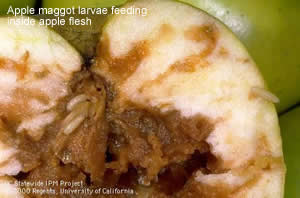Invasive species are introduced by human intervention and are directly related to the rise of global transportation of people, goods, and foods. They are often pests requiring large amounts of financial intervention in order to control. In the United States, losses and damages from invasive weeds cost the agricultural industry about $24 billion annually, and invasive insect pests cost $13.9 billion annually. Most of these crop pests were accidentally introduced along with imported crops, crop seeds, soil, and plant materials (Pimentel 2005). Global crop transport is a serious issue when it comes to invasive species in agricultural systems, since the vast majority of invasive crop pests come into farms on imported produce, including insects, microorganisms, spores, seeds, and eggs.
For instance, the most charismatic of Washingtonian agricultural products is undoubtedly the Washington Apple. Of course, we humans have known for quite some time, one bad apple can indeed spoil the bunch. As a case study for Washingtonian agriculture, here we will examine the Apple Maggot. Apple Maggots are native to the Eastern United States. They were first discovered in Washington State in Clark County in 1980. From there, the exotic fruit fly larvae have been detected in every Western Washington county west of the Cascades (Washington Invasive Species Council).
The Washington State Department of Agriculture believes the spread is most likely due to the transport of infected apples. The entirety of Western Washington has been quarantined for Apple Maggot, all fruit shipments must be certified to be Apple Maggot free, and homegrown fruit is not permitted to be taken outside of the quarantine area, as homegrown fruit is not widely screened for apple maggot infestation (WSDOA 2011). Apple Maggot threatens Washington State's over $2.8 billion tree fruit industry, leading to a campaign to spread awareness (Jensen 2004). These signs have become familiar to many drivers along Washington highways:
As the numbers show, the threat to agriculture by these species is serious. Local food systems are more insulated from global exotic pests. By allowing food to stay in the local food system, the odds of invasive species import are greatly reduced. There are many more invasive species which have not yet arrived in Washington state, but groups such as the Washington State Invasive Species Council and Department of Agriculture believe there is a high risk for.
Viral Hemorrhagic Septicemia: Threatens local salmon and trout populations
The gypsy moth costs the U.S. $30 million per year with damage to tree nurseries.
The aquaculture and timber industries are concerned about these pests invading. The state has already seen numerous transient invasions of gypsy moth, but there have been no established populations. Viral Hemorrhagic Septicemia has already been found in freshwater fish populations in Washington, but may spread out to saltwater with time. These dangers are clearly imminent, and once an invasive species infests a crop, removal becomes very difficult. Because of this, it is once a species appears to threaten an area that costly prevention measures are immediately put in place to provide protection to local agriculture.
In order to lessen these threats, keeping crops local will keep invasive species at bay by reducing the spread of worldwide pests to local ecosystems.




No comments:
Post a Comment